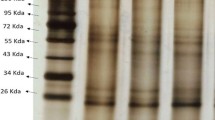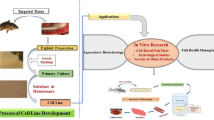Abstract
Lack of a valid shrimp cell line has been hampering the progress of research on shrimp viruses. One of the reasons identified was the absence of an appropriate medium which would satisfy the requirements of the cells in vitro. We report the first attempt to formulate an exclusive shrimp cell culture medium (SCCM) based on the haemolymph components of Penaeus monodon prepared in isosmotic seawater having 27 ‰ salinity. The SCCM is composed of 22 amino acids, 4 sugars, 6 vitamins, cholesterol, FBS, phenol red, three antibiotics, potassium dihydrogen phosphate and di-sodium hydrogen phosphate at pH 6.8–7.2. Osmolality was adjusted to 720 ± 10 mOsm kg−1 and temperature of incubation was 25 ºC. The most appropriate composition was finally selected based on the extent of attachment of cells and their proliferation by visual observation. Metabolic activity of cultured cells was measured by MTT assay and compared with that in L-15 (2×), modified L-15 and Grace’s insect medium, and found better performance in SCCM especially for lymphoid cells with 107 % increase in activity and 85 ± 9 days of longevity. The cells from ovary and lymphoid organs were passaged twice using the newly designed shrimp cell dissociation “cocktail”.









Similar content being viewed by others
References
Antoine FR, Wei CI, Littell RC, Marshall MR (1999) HPLC method for analysis of free amino acids in fish using o-phthaldialdehyde precolumn derivatization. J Agric Food Chem 47:5100–5107
Assavalapsakul W, Smith DR, Panyim S (2006) Identification and characterization of a Penaeus monodon lymphoid cell-expressed receptor for the yellow head virus. J Virol 80:262–269
Bruland KW, Donat JR, Hutchins DA (1991) Interactive influences of bioactive trace metals on biological production in oceanic waters. Limnol Oceanogr 36:1555–1577
Carvalho AP, Malcata FX (2005) Preparation of fatty acid methyl esters for gas-chromatographic analysis of marine lipids: insight studies. J Agric Food Chem 53:5049–5059
Chen SN, Kou GH (1989) Infection of cultured cells from lymphoid organ of Penaeus monodon Fabricius by monodon-type baculovirus (MBV). J Fish Dis 12:73–76
Chen SN, Wang CS (1999) Establishment of cell culture systems from penaeid shrimp and their susceptibility to white spot disease and yellow head viruses. Meth Cell Sci 21:199–206
Chen SN, Chi SC, Kou GH, Liao IC (1986) Cell culture from tissues of grass prawn, Penaeus monodon. Fish Pathol 21:161–166
Chen SN, Jong KJ, Kou GH (1988) Cell cultures from hematopoietic tissue and ovary of penaeid shrimp, Penaeus monodon. In: Kuroda Y, Kurstak E, Maramorosch K (eds) Invertebrate and fish tissue culture. Springer, Berlin, pp 195–198
Chen SN, Jong KJ, Kou GH (1989) Cell cultures derived from tissues of penaeid shrimp, Penaeus penicillatus and hard clam, Meretrix lusoria. In: Mitsuhashi J (ed) Invertebrate cell system applications. CRC Press Inc., Florida, pp 253–262
Chun-Lei G, Jin-Sheng S, Jian-Hai X (2003) Primary culture and characteristic morphologies of medulla terminalis neurons in the eyestalks of Chinese shrimp, Fenneropenaeus chinensis. J Exp Mar Biol Eco 290:71–80
Dall W (1981) Osmoregulatory ability and juvenile habitat preference in some penaeid prawns. J Exp Mar Biol 54:55–64
Fan TJ, Wang XF (2002) In vitro culture of embryonic cells from the shrimp, P. chinensis. J Exp Mar Biol Eco 267:175–184
Fraser CA, Hall MR (1999) Studies on primary cell cultures derived from ovarian tissue of Penaeus monodon. Meth Cell Sci 21:213–218
Freshney RI (2000) Culture of animal cells: a manual of basic technique. Wiley-Liss, New York
George SK, Dhar AK (2010) An improved method of cell culture system from eye stalk, hepatopancreas, muscle, ovary, and hemocytes of Penaeus vannamei. In Vitro Cell Dev Biol Anim 46:801–810
George SK, Kaizer KN, Betz YM, Dhar AK (2011) Multiplication of Taura syndrome virus in primary hemocyte culture of shrimp (Penaeus vannamei). J Virol Methods 172:54–59
Ghosh D, Ray AK, Dasmahapatra AK (1995) Primary culture of prawn hepatocytes in serum free media. In Vitro Cell Dev Biol Anim 31:811–813
Grace TDC (1962) Establishment of four strains of cells from insect tissues grown in vitro. Nature 195:788–789
Hu GB, Wang D, Chen J-X (2010) Retroviral delivery of simian virus 40 large T antigen gene into primary cultured ovary cells of the penaeid shrimp, Penaeus chinensis: indirect evidence of retroviral integration. J World Aquacult Soc 41:137–143
Huang J, Song XL, Yu J, Zhang LJ (1999) The components of an inorganic physiological buffer for Penaeus chinensis. Meth Cell Sci 21:223–225
Itami T, Maeda M, Kondo M, Takahashi Y (1999) Primary culture of lymphoid organ cells and haemocytes of kuruma shrimp, Penaeus japonicus. Meth Cell Sci 21:237–244
Jayesh P, Seena J, Singh ISB (2012) Establishment of shrimp cell lines: perception and orientation. Indian J Virol. doi:10.1007/s13337-012-0089-9
Jiang YS, Zhan WB, Wang SB, Xing J (2005) Development of primary shrimp hemocyte cultures of Penaeus chinensis to study white spot syndrome virus (WSSV) infection. Aquaculture 253:114–119
Jose S (2009) Cell culture from Penaeus monodon: development and application. Ph.D. Thesis. Cochin University of Science and Technology, India
Jose S, Mohandas A, Philip R, Singh ISB (2010) Primary hemocyte culture of Penaeus monodon as an in vitro model for white spot syndrome virus titration, viral and immune related gene expression and cytotoxicity assays. J Invertebr Pathol 105:312–321
Jose S, Jayesh P, Mohandas A, Philip R, Singh ISB (2011) Application of primary haemocyte culture of Penaeus monodon in the assessment of cytotoxicity and genotoxicity of heavy metals and pesticides. Mar Environ Res 71:169–177
Jose S, Jayesh P, Sudheer NS, Poulose G, Mohandas A, Philip R, Bright ISB (2012) Lymphoid organ cell culture system from Penaeus monodon (Fabricius) as a platform for white spot syndrome virus and shrimp immune-related gene expression. J Fish Dis 35:321–334
Kasornchandra J, Khongpradit R, Ekpanithanpong U, Boonyaratpalin S (1999) Progress in the development of shrimp cell cultures in Thailand. Meth Cell Sci 21:231–235
Kester DR, Duedall IW, Connors DN, Pytkowicz RM (1967) Preparation of artificial seawater. Limnol Oceanogr 12:176–179
Kumar GS, Singh ISB, Philip R (2001) Cell culture systems from the eye stalk of Penaeus indicus. In: Lindner-Olsson E, Chatzissavidou N, Lullau E (eds) Animal cell technology: from target to market. Kluwer, London, pp 261–265
Kumar VJR, Achuthan C, Manju NJ, Philip R, Bright Singh IS (2009) Activated packed bed bioreactor for rapid nitrification in brackish water hatchery systems. J Ind Microbiol Biot 36:355–365
Lang GH, Nomura N, Matsumura M (2002) Growth by cell division in shrimp (Penaeus japonicas) cell culture. Aquaculture 213:73–83
Lu Y, Tapay LM, Loh PC, Brock JA, Gose RB (1995) Distribution of yellow-head virus in selected tissues and organs of penaeid shrimp Penaeus vannamei. Dis Aquat Organ 23:67–70
Luedeman R, Lightner DV (1992) Development of an in vitro primary cell system from the penaeid shrimp, Penaeus stylirostris and Penaeus vannamei. Aquaculture 101:205–211
Lynn DE (2001) Novel techniques to establish new insect cell lines. In Vitro Cell Dev-An 37:319–321
Machii A, Wada KT, Awaji M, Nakamura HK, Townsley SJ (1988) Some characters of cells of the midgut gland and chytrids from primary cultures of the prawn Penaeus japonicus. In: Kuroda Y, Kurstak E, Mararnorosch K (eds) Invertebrate and fish tissue culture. Japanese Scientific Societies Press, Tokyo, pp 11–14
Maeda M, Mizuki E, Itami T, Ohba M (2003) Ovarian primary tissue culture of the kuruma shrimp Marsupenaeus japonicus. In Vitro Cell Dev Biol Anim 39:208–212
Maeda M, Saitoh H, Mizuki E, Itami T, Ohba M (2004) Replication of white spot syndrome virus in ovarian primary cultures from the kuruma shrimp, Marsupenaeus japonicus. J Virol Methods 116:89–94
Mitsuhashi J (2001) Development of highly nutritive culture media. In Vitro Cell Dev-An 37:330–337
Mosmann T (1983) Rapid colorimetric assay for cellular growth and survival: application to proliferation and cytotoxicity assays. J Immunol Methods 65:55–63
Mulford AL, Austin B (1998) Development of primary cell culture from Nephrops norvegicus. Meth Cell Sci 19:269–275
Mulford AL, Lyng F, Mothersill C, Austin B (2001) Development and characterization of primary cell cultures from the hematopoietic tissues of the Dublin Bay prawn, Nephrops norvegicus. Meth Cell Sci 22:265–275
Nadala E, Loh PC, Lu Y (1993) Primary culture of lymphoid, nerve and ovary cells from Penaeus stylirostris and Penaeus vannamei. In Vitro Cell Dev-An 29:620–622
Najafabadi AK, Ellender RD, Middlebrooks BL (1992) Analysis of shrimp hemolymph and ionic modification of a Penaeus cell culture formulation. J Aquat Anim Health 4:143–148
Shike HS, Klimpel KS, Burns JC (2000) Expression of foreign genes in primary cultured cells of the blue shrimp Penaeus stylirostris. Mar Biol 137:605–611
Shimizu C, Shike H, Klimpel KR, Burns JC (2001) Hemolymph analysis and evaluation of newly formulated media for culture of shrimp cells (Penaeus stylirostris). In Vitro Cell Dev Biol Anim 37:322–329
Tapay L, Lu Y, Brock JA, Nadala ECB, Loh PC (1995) Transformation of primary cultures of shrimp (Penaeus stylirostris) lymphoid (Oka) organ with simian virus-40 (T) antigen. Proc Soc Exp Biol Med 209:73–78
Tong SL, Miao HZ (1996) Attempts to initiate cell cultures from Penaeus chinensis tissues. Aquaculture 146:151–157
Toullec JYC, Patrois J, Porcheron P (1996) Development of primary cell cultures from the penaeid shrimps Penaeus vannamei and P. indicus. J Crustacean Biol 16:643–649
Wang CH, Yang HN, Tang CY, Lu CH, Kou GH, Lo CF (2000) Ultrastructure of white spot syndrome virus development in primary lymphoid organ cell cultures. Dis Aquat Organ 41:91–104
Wyatt GR, Loughheed TC, Wyatt SS (1956) The chemistry of hemolymph- organic components of the hemolymph of the silkworm, Bombyx mori, and two other species. J Gen Physiol 39:853–865
Acknowledgments
This research was supported by Department of Biotechnology, Government of India (BT/PR8050/AAQ/03/289/2006). The first author thanks DBT for Fellowship.
Author information
Authors and Affiliations
Corresponding author
Rights and permissions
About this article
Cite this article
Jayesh, P., Jose, S., Philip, R. et al. A novel medium for the development of in vitro cell culture system from Penaeus monodon . Cytotechnology 65, 307–322 (2013). https://doi.org/10.1007/s10616-012-9491-9
Received:
Accepted:
Published:
Issue Date:
DOI: https://doi.org/10.1007/s10616-012-9491-9




